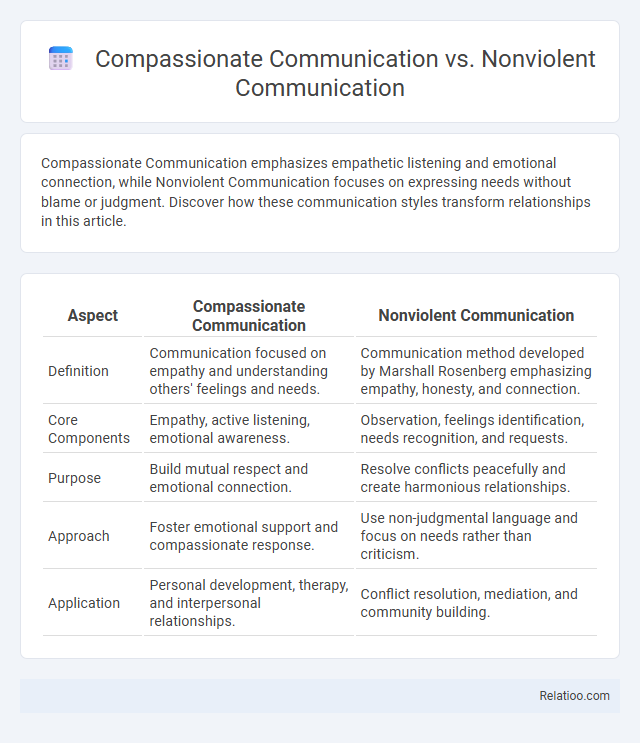Compassionate Communication emphasizes empathetic listening and emotional connection, while Nonviolent Communication focuses on expressing needs without blame or judgment. Discover how these communication styles transform relationships in this article.
Table of Comparison
| Aspect | Compassionate Communication | Nonviolent Communication |
|---|---|---|
| Definition | Communication focused on empathy and understanding others' feelings and needs. | Communication method developed by Marshall Rosenberg emphasizing empathy, honesty, and connection. |
| Core Components | Empathy, active listening, emotional awareness. | Observation, feelings identification, needs recognition, and requests. |
| Purpose | Build mutual respect and emotional connection. | Resolve conflicts peacefully and create harmonious relationships. |
| Approach | Foster emotional support and compassionate response. | Use non-judgmental language and focus on needs rather than criticism. |
| Application | Personal development, therapy, and interpersonal relationships. | Conflict resolution, mediation, and community building. |
Understanding Compassionate Communication
Compassionate Communication centers on empathetic listening and expressing feelings and needs honestly to foster deeper human connections and conflict resolution. Unlike Nonviolent Communication, which follows a structured four-step process, Compassionate Communication emphasizes genuine emotional awareness and mutual respect in interactions. Your ability to practice Compassionate Communication enhances relationships by promoting understanding and kindness without judgment.
Defining Nonviolent Communication
Nonviolent Communication (NVC) is a communication process developed by Marshall Rosenberg that emphasizes empathetic listening and honest expression to foster mutual understanding and resolve conflicts peacefully. It involves four key components: observations, feelings, needs, and requests, which guide individuals to connect authentically without judgment or blame. Unlike broader compassion or general compassionate communication, NVC provides a structured approach designed explicitly to promote nonviolence in interpersonal interactions and social change.
Key Principles of Compassionate Communication
Compassionate Communication centers on empathetic listening, honest expression, and recognizing shared human needs to foster mutual understanding and connection. This approach emphasizes your awareness of emotions and intentions behind words, encouraging respect and non-judgmental dialogue. Unlike Nonviolent Communication, which follows a precise four-step process, Compassionate Communication is broader, integrating compassion as an organic way of engaging with yourself and others.
Core Elements of Nonviolent Communication
Nonviolent Communication (NVC) centers on four core elements: observation without judgment, expressing feelings, identifying needs, and making clear requests, fostering empathy and mutual understanding. Compassionate Communication shares similarities but emphasizes emotional resonance and kindness beyond NVC's structured framework. Compassion involves a broader, innate human capacity to recognize suffering and act with care, whereas NVC provides a specific, actionable methodology designed to resolve conflict and deepen connections.
Similarities Between Compassionate and Nonviolent Communication
Compassionate Communication and Nonviolent Communication both prioritize empathy, active listening, and expressing feelings without judgment to foster understanding and connection between individuals. These approaches help you create meaningful dialogue by emphasizing respect for everyone's needs and emotions, promoting peaceful and constructive interactions. Compassion is the underlying foundation that motivates both methods, inspiring kindness and genuine concern in communication practices.
Differences Between Compassionate and Nonviolent Communication
Compassionate Communication centers on empathetic listening and expressing feelings authentically to foster understanding, whereas Nonviolent Communication (NVC) follows a structured four-step process involving observations, feelings, needs, and requests to resolve conflicts peacefully. The key difference lies in NVC's emphasis on explicit linguistic patterns designed to prevent judgment and blame, while Compassionate Communication is broader, emphasizing emotional presence and connection. Compassion, more generally, refers to the deep awareness of others' suffering combined with a desire to help, serving as the foundational attitude underpinning both communication styles but not limited to specific communication techniques.
Practical Techniques in Compassionate Communication
Practical techniques in Compassionate Communication emphasize active listening, expressing needs clearly, and empathetic dialogue to foster understanding and connection. This approach differs from Nonviolent Communication by incorporating broader emotional awareness and mindfulness practices tailored to specific relational contexts. Compassion in communication centers on genuine care and kindness, but Compassionate Communication provides structured methods like mirroring feelings, using "I" statements, and avoiding blame to resolve conflicts effectively.
Strategies from Nonviolent Communication
Nonviolent Communication (NVC) employs strategies such as empathetic listening, expressing observations without judgments, and articulating feelings and needs to foster genuine connection and understanding. Unlike general Compassionate Communication, NVC emphasizes specific techniques like using "I" statements and requests rather than demands to reduce defensiveness and promote cooperation. Practicing these NVC strategies encourages compassionate interactions by recognizing mutual humanity and addressing underlying needs directly.
Benefits of Compassionate and Nonviolent Communication
Compassionate Communication and Nonviolent Communication both foster empathy, trust, and understanding, enhancing relational harmony and reducing conflicts. These communication styles promote active listening and expression of feelings without blame, leading to improved emotional connections and collaborative problem-solving. Emphasizing compassionate dialogue nurtures psychological safety, which boosts cooperation and supports mental well-being in personal and professional environments.
Choosing the Right Approach for Effective Dialogue
Compassionate Communication emphasizes expressing empathy and understanding emotions to foster connection, while Nonviolent Communication (NVC) provides a structured framework centered on observing without judgment, identifying feelings, needs, and making clear requests. Compassion as a broader concept involves genuine care and kindness, serving as the foundation for both approaches. Choosing the right approach depends on the context and goals--NVC is ideal for conflict resolution with its precise techniques, whereas Compassionate Communication suits building emotional rapport and deepening relationships.

Infographic: Compassionate Communication vs Nonviolent Communication
 relatioo.com
relatioo.com